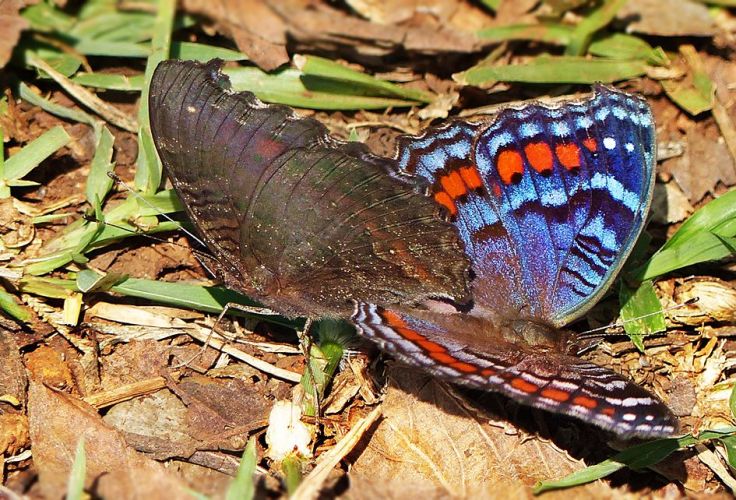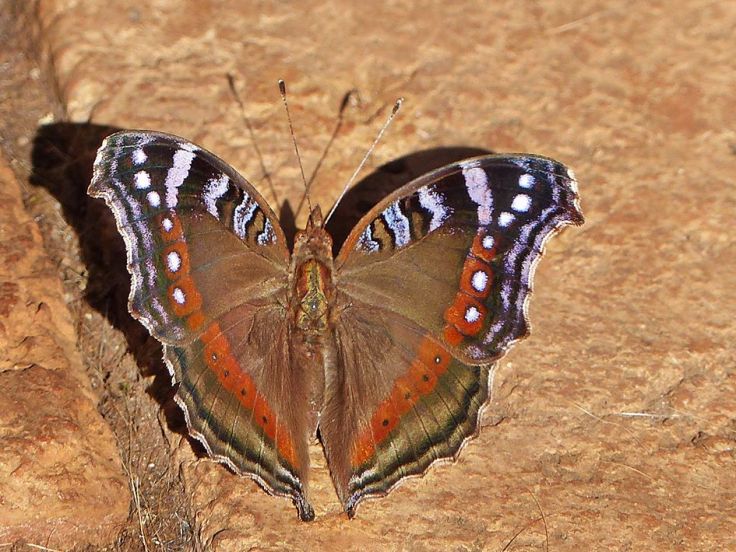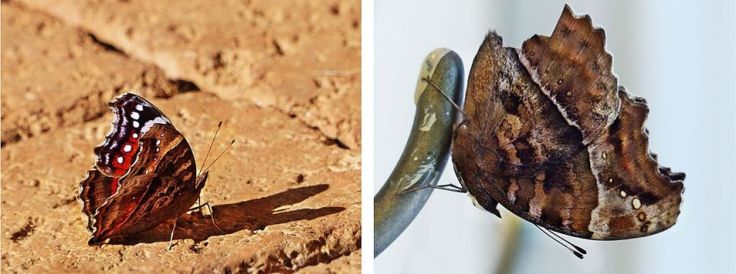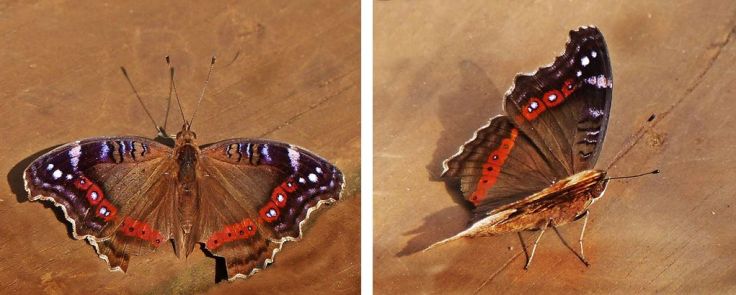Even those who don’t like caterpillars tend to like butterflies, perhaps forgetting that caterpillars are the larvae of butterflies?
Butterflies and moths grace many gardens, parks and natural spaces. I’d like to think that anyone interested in butterflies can observe them where they still occur, can read field guides or access the remarkable photographs and reference sources that are available online these days. I am hopeful that the hobby of catching, killing and then mounting and pinning butterflies is in decline. Fine-tuning the categorization (taxonomy) of insects can safely be left to specialists, and those of us learning about butterflies can do so without killing them.
In late summer into autumn, our garden is alive with flying butterflies. Most of them are too active to be approached by me with my camera, but of course, they are appreciated anyway! However, there are some that have been approachable, including this mating pair of Gaudy Commodores.

The Gaudy Commodore breeds twice a year and the subspecies Precis octavia sesamus has a wet season form and a dry season form. In this photo, taken in late winter in August, the dry season form colouration can be seen. In the wet season form the colouration is predominantly red-orange. The two forms are so different that it is hard to believe that they are forms of the same species of butterfly
The Gaudy Commodore belongs to the Nymphalidae-Nymphalinae family of butterflies. Its habitat is predominantly savannah and it occurs throughout sub-Saharan Africa. The caterpillars of the Gaudy Commodore are about 45 mm in length and they are tawny brown in colour, banded with black. They carry branched spines along the length of their body and a pair of spines on the head.

The wingspan of the Gaudy Commodore is 50-63 mm, and the colours of the males and females are the same. The females lay eggs on shoots of specific host plants, mostly grassland plants in the mint family, including Plectranthus
All butterfly and moth families belong to the order Lepidoptera, the name deriving from the ancient Greek lepidos meaning ‘scale’ and pteron meaning ‘wing’. The powdery coating on their wings is made up of tiny scales. Butterflies and moths are important pollinators. They feed on liquid substances such as nectar from flowers, and some drink fluid from over-ripe fruit and other plant sources as well as from moist dung from animals. A small minority don’t eat at all when in their adult phase. They exist for only a short time, but long enough to procreate.
Our garden is visited by another species of Precis butterfly, this being the Garden Commodore, also known as the Garden Inspector (Precis archesia). Like the Gaudy Commodore, it occurs in sub-Saharan Africa, and it too has a dry season and a wet season form.

A Garden Commodore butterfly in its dry season form. It is thought that the temperature during the stage of pupal development determines the colour form of the adult

The colouration of the outside of the wing conceals the brighter colours that are only revealed when the wings are open

Spreading its wings, this Garden Commodore shows that its wings have undergone some wear and tear
In common with the Gaudy Commodore, the Garden Commodore is also a creature of the savannah, although they are now being found in deforested areas and gardens. The adult butterflies of both species feed on nectar from flowers. So when planting to attract butterflies, think in terms of the needs of both the adult butterfly as well as its larvae.
Sources:
Project Noah: Gaudy Commodore http://www.projectnoah.org/spottings/130016640; Steve Woodhall. 2013. Butterflies of South Africa. Cape Town. Struik Nature Pocket Guide; IUCN Red List of Threatened Species: Precis Octavia http://www.iucnredlist.org/details/159960/0
Posted by Carol









March 15, 2017 at 4:51 am
I find butterflies very difficult to photograph, so have really enjoyed your pictures.
LikeLike
March 15, 2017 at 10:52 am
Thanks Anne. These butterflies were unusual as they stayed relatively still.
LikeLike
March 14, 2017 at 10:57 pm
Great post and stunning photos! While collecting is still useful for scientific purposes, I agree with you about the old practice of catching and mounting butterflies by hobbyists. Often this was done simply to frame and hang on the wall. Fortunately, modern digital cameras have allowed a less intrusive type of “collecting” and this has the advantage of showing behaviour and habitat – which a mounted specimen can’t.
LikeLike
March 15, 2017 at 5:47 am
Thanks Carol. I agree with what you say about collecting. I am astonished and sad to see the online trade in mounted and framed insects. My late dad was an entomologist and he wished that children were taught to respect life first and not suppress that in the interests of so-called scientific pursuits. When he had to collect specimens he would do so with sadness and take as few as possible.
LikeLiked by 1 person
March 15, 2017 at 6:24 am
Your father had a good attitude.
LikeLiked by 1 person
March 10, 2017 at 8:03 am
What stunning creatures (for avoidance of doubt, I am a caterpillar lover also) … your pictures are breathtaking and the script fascinating. Thank you. I feel improved 😊
LikeLiked by 2 people
March 10, 2017 at 8:31 am
Thanks for the lovely comment, Osyth!
LikeLiked by 1 person
March 10, 2017 at 8:49 am
My pleasure 😊
LikeLike
March 10, 2017 at 2:05 am
Lovely butterflies.
LikeLiked by 1 person
March 10, 2017 at 5:28 am
Thank you Sherry. Indeed they are lovely.
LikeLiked by 1 person
March 9, 2017 at 10:13 pm
Beautifully colourful and exotic species! Fabulous photographs!
LikeLiked by 1 person
March 10, 2017 at 5:27 am
Thank you for your kind comment Pete. Of course they are not exotic to us ☺
LikeLiked by 1 person
March 9, 2017 at 10:09 pm
How wonderfully gaudy. Far more so than any I’ve seen on the wing in Europe.
LikeLiked by 1 person
March 10, 2017 at 5:25 am
Gaudy does describe them well. Not so sure about the commodore part. Guess the connection is flight.
LikeLiked by 1 person
March 10, 2017 at 7:02 am
Oh well, it we can have admirals, red ones, I’m sure you can have commodores.
LikeLiked by 1 person
March 10, 2017 at 7:35 am
🙂 Strange that they all sound rather more nautical than airborne!
LikeLiked by 1 person
March 9, 2017 at 9:43 pm
Beautiful species! 🙂
LikeLiked by 1 person
March 10, 2017 at 5:22 am
Thank you Tom. They are lovely creatures.
LikeLike
March 9, 2017 at 8:53 pm
Thanks for sharing these beautiful butterflies.
LikeLiked by 1 person
March 10, 2017 at 5:21 am
Thanks Sandy. A pleasure to share!
LikeLiked by 1 person